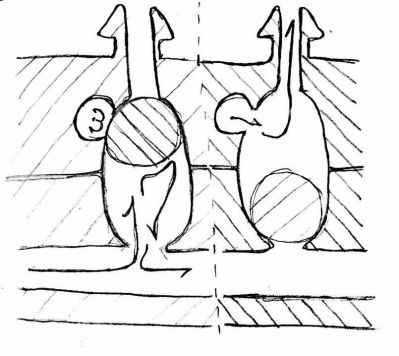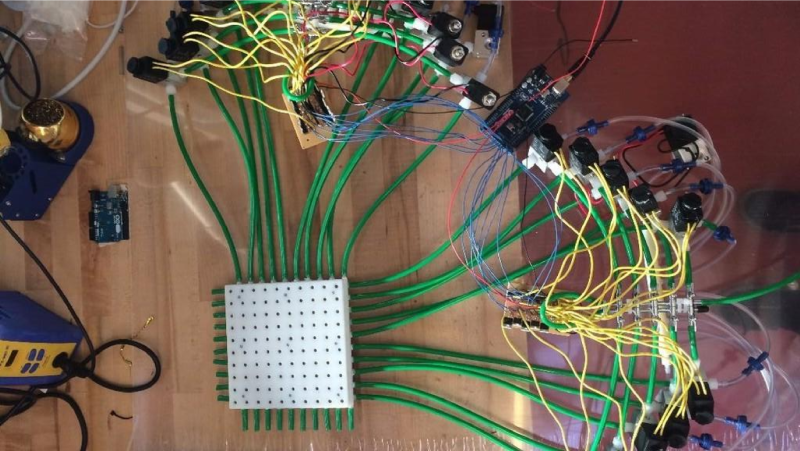This is a pretty cool project [Sebastian Morales] is working on – a 3D printed Pneumatic Multiplexer. Large interactive installations, kinetic art and many other applications require large numbers of actuators to be controlled. For these type of projects to work, a large number of actuators equals higher resolution and that allows the viewer to be captivated by the piece.
The larger the system becomes, the more complex it becomes to control all of those actuators. [Sebestian] wanted to move a large number of components with a relatively low number of inputs. He thought of creating a mechanical equivalent of the familiar electronic X-Y matrix that can control large quantities of outputs using only a few inputs – in a more descriptive form, Outputs=(Inputs/2)^2.
 He looked at chemical reactions that change liquids in to gases, but that seemed pretty complicated. Refrigerants used in air conditioning looked promising, but their handling and safety aspects looked challenging.
He looked at chemical reactions that change liquids in to gases, but that seemed pretty complicated. Refrigerants used in air conditioning looked promising, but their handling and safety aspects looked challenging.
Eventually, he decided to look at using “air logic“. Air logic uses pneumatic devices to create relays, limit switches, AND gates, NAND gates, OR gates, amplifiers, equivalent to electrical circuits. Electrical energy is replaced with compressed air. His plan was to build a multiplexer whose elements would open only if the combination of pressure between both lines was the right one. As in electronics, NAND logic is easy to implement. A moving element creates a seal and only allows air out if the bottom line was low and the top line was high.
He had access to a high resolution, resin based 3D printer which allowed him to create fully air-tight systems. He started with prototyping a small 4×4 matrix to test out his design, and had to work through 6 to 7 iterations before he could get it to work. The next step was to create a larger matrix of 100 elements controlled by 20 inputs (10×10 matrix). He created Omnifarious – a kinetic sculpture demonstrating the concept of shapeshifting objects. The Omnifarious is a hexecontahedron which would be able to transform its surface to render different geometries via 59 balloons on its surface. Below, you can check the videos of his progress building the various prototypes and another video showing the Omnifarious sculpture.
Prototyping
Omnifarious – Shapeshifting objects
















Looks like something you might find in an adult store. Ebay often has new and used pneumatic manifolds with 30 to 50 individual controllable outputs for not too much money.
Reminded me of that old late 60’s movie Barbarella. A good prop to use in a bizarro modern day remake.
It might be just the thing that the braille display project posted here a few weeks ago needs…
.. and blast the one other sense the users has with the sound of a compressor.
but no, you might be on to something..
All the other option can also be loud – the other tons of servos, solenoids. This at least reduce the numbers of noisy solenoids needed because it is O(n^1/2) and not O(n), so all things equal, it can be quieter for a large matrix.
It is a matter of sound proofing things. Sound proofing Pneumatic can be a bit easier as you are not constrained by requiring direct mechanical linkages.
I could even use a cubed (^3) matrix flattened in theory, would still need a lot of actuators, but I am working on them anyway. I really like the look of this for future iterations of the Braille computer, but every few days I see or get told about a better way to build and now I have to settle if I am going to make the HaD prize closing date with a functioning machine.
This is strangely soothing to watch…
You can actually make those without a single moving part. The air streams will deflect each other when they collide and they will stick to curved surfaces. That is enough for simple logic elements, triggers etc.
They were mass produced in the USSR, but I have no idea where they were used.
Here the 3rd photo shows how it sorta works, you can see the air channels and their configuration.
But the link is in russian.
http://urban3p.ru/blogs/24787/
that is for linear flow. what about the back pressure of the balloon ?
If you could make one large enough to get the controller and compressor inside, it would make a great all terrain robot.
Cool, a bit slow and steady rate though. Couldn’t play a piano etc. Would like to see all the balloons blown up. A blastula!
The Russian stuff is fluidic logic. I once read a cold war article in Pop-Sci mag about fluidics, how we could make missile guidance that was nuke proof. So did the other side as well apparently.
My favorite is the 1913 dual 4bit D to A for 16 (regulated by a servo valve) levels of bass and treble playing volume on the Duo Art player piano. It was fast enough to control per each note in a sequence at a fast tempo.
Read up on this “lost” tech, there are certain designs you could use as to speed and pouch valves in particular. If this tech had been around half a century earlier, Babbage would have been able to make the things he designed. Go back a whole century and we would have digital recordings of the great classical pianists. Wood and leather, not exactly high tech.
This is actually a demux, it converts an electric signal into several pneumatic components.
A more interesting version would control a matrix of pneumatically controlled pneumatic valves, such as moving a ball bearing in a bistable fashion.
That way one can control many outputs virtually simultaneously by toggling them.
yes that would be a great thing to have.
maybe the ball is made from steel and pushed against a magnet. and other air stream would then force it away from the magnet again in order to release it.
As well as the self motivated ball mentioned by others, this would be great for a ‘road side’ dot matrix display (moving hi-vis markers in opaque liquid – in fact the liquid could be the motive force).
I wonder whether the actuator could include some form of latch, thus holding it’s position regardless of the back pressure.
Glad it found this! I’m trying to find out all I can on the FLODAC , patent 3190554, so I can 3D print one of my own . Anybody out there know if the FLODAC is still around in a museum somewhere?
Is there any possibility to get 3D files of this multiplexer 4×4?